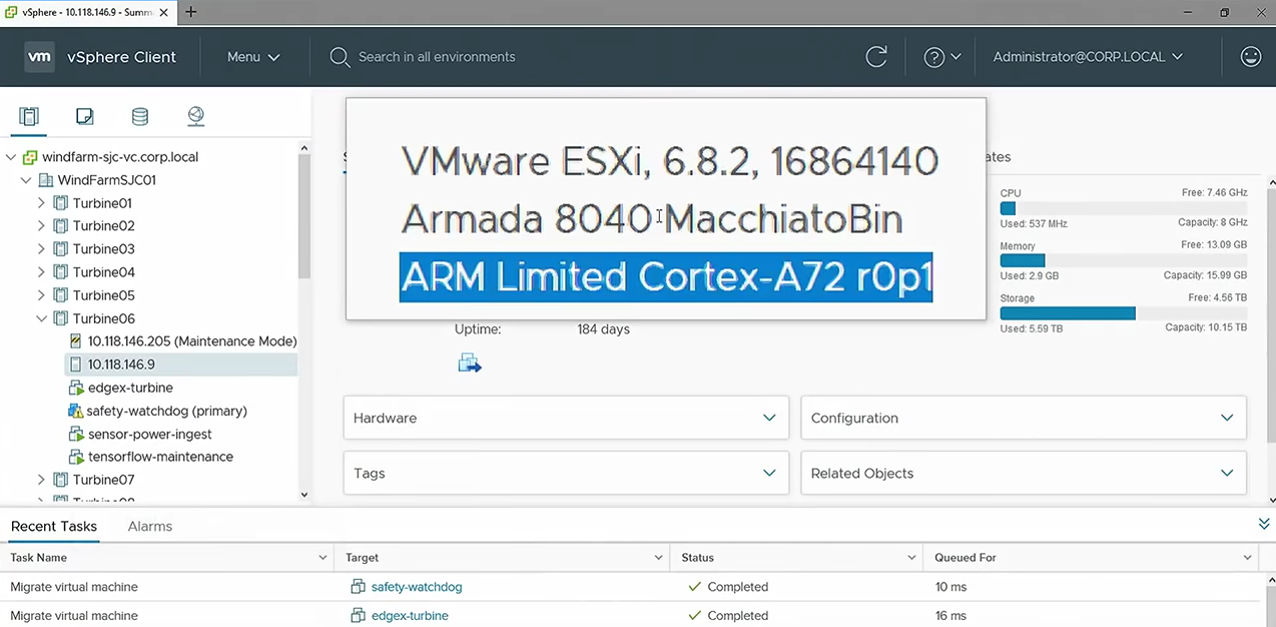This is certainly a question I’ve been pondering for a few weeks since the announcements at VMworld 2018 and where Ray O’Farrell presented ESXi running on an ARM Cortex A72 device. Since my last post covering some VMware news, I’ve been asking – is there any logic in running a hypervisor on an IoT platform and if so, what are the benefits?

It’s Not Raspberry Pi
Despite the presentations to the contrary, we’re not talking Raspberry Pi devices here. Although RPi devices could be used for limited scenarios like vSAN quorum devices, the target platform is 64-bit ARM and likely embedded devices. The VMworld presentation showed two hardware platforms with four running applications. The power of using virtualisation is in enabling fault tolerance for applications that need both high uptime and have limited supportability. In the wind turbines example, minimising the visits to turbines is essential. At the same time, each turbine can’t practically support an entire data centre, so IoT devices based on ARM provide more efficient compute power.
Efficiency vs Management
The balance between platform efficiency and management is the key benefit for considering ESXi at the edge. IoT devices will be low power, low maintenance and potentially embedded devices. But, these devices still need managing. If the expected levels of scale are to be achieved with IoT, then the management problems need to be addressed. We already have millions of devices deployed, such as cameras and sensors. These IoT hardware platforms have no structured way in which to be upgraded and maintained. In fact, many have already been compromised for use as spam emailers and botnets.
Framework
Rather than being excited about the prospect of running ESXi across a range of Raspberry Pis, the real prize here is putting in place a framework for automation, resiliency and support. Low-cost ARM devices can now be configured with extra resiliency, while separating the application from the hardware. The hypervisor can easily be remotely patched on each device, while the application runs on another piece of fallback hardware.
Kubernetes at the Edge?
Of course, the alternative is to provide capabilities to run applications as containers across multiple ARM devices. This has been possible for years with Docker, for example. So what advantage could VMware provide over a container infrastructure? Certainly, the existing management processes remain the same; visualisation through existing tools remains the same too. With lightweight Linux kernels running applications, ESXi could be as efficient as a containerised environment, but with all of VMware’s existing security and management capabilities. Time will tell if containerisation or virtualisation will win out.
The Architect’s View
ESXi on ARM is currently only being previewed as a teaser technology. However, when thinking about it in the way virtualisation wasn’t originally designed (which was a hardware consolidation/efficiency play), but rather as a management tool, the logic makes sense. As always though, this is a limited scenario and other questions abound, specifically how secure networking and data mobility can be implemented. ESXi on ARM may not seem like such a wild idea after all.
Comments are always welcome; please read our Comments Policy first. If you have any related links of interest, please feel free to add them as a comment for consideration.
Copyright (c) 2009-2019 – Post #3562 – Chris M Evans, first published on https://www.architecting.it/blog, do not reproduce without permission.

